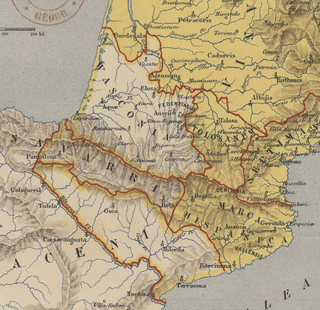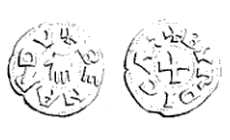
Aquitaine, archaic Guyenne or Guienne, is a historical region of southwestern France and a former administrative region of the country. Since 1 January 2016 it has been part of the region of Nouvelle-Aquitaine. It is situated in the southwest corner of Metropolitan France, along the Atlantic Ocean and the Pyrenees mountain range on the border with Spain, and for most of its written history Bordeaux has been a vital port and administrative center. It is composed of the five departments of Dordogne, Lot-et-Garonne, Pyrénées-Atlantiques, Landes and Gironde. Gallia Aquitania was established by the Romans in ancient times and in the Middle Ages, Aquitaine was a kingdom and a duchy, whose boundaries fluctuated considerably.

Gascony was a province of the southwestern Kingdom of France that succeeded the Duchy of Gascony (602–1453). From the 17th century until the French Revolution (1789–1799), it was part of the combined Province of Guyenne and Gascony. The region is vaguely defined, and the distinction between Guyenne and Gascony is unclear; by some they are seen to overlap, while others consider Gascony a part of Guyenne. Most definitions put Gascony east and south of Bordeaux.

The Duchy of Aquitaine was a historical fiefdom in western, central, and southern areas of present-day France to the south of the river Loire, although its extent, as well as its name, fluctuated greatly over the centuries, at times comprising much of what is now southwestern France (Gascony) and central France.

The Battle of Roncevaux Pass in 778 saw a large force of Basques ambush a part of Charlemagne's army in Roncevaux Pass, a high mountain pass in the Pyrenees on the present border between France and Spain, after his invasion of the Iberian Peninsula.

Lower Navarre is a traditional region of the present-day French département of Pyrénées-Atlantiques. It corresponds to the northernmost merindad of the Kingdom of Navarre during the Middle Ages. After the Spanish conquest of Iberian Navarre (1512–24), this merindad was restored to the rule of the native king, Henry II. Its capitals were Saint-Jean-Pied-de-Port and Saint-Palais. In the extreme north there was the little sovereign Principality of Bidache, with an area of 1,284 km2 (496 sq mi) and a decreasing population of 44,450, 25,356.

Labourd is a former French province and part of the present-day Pyrénées Atlantiques département. It is one of the traditional Basque provinces, and identified as one of the territorial component parts of the Basque Country by many, especially by the Basque nationalists.

The Kingdom of Navarre, originally the Kingdom of Pamplona, was a Basque kingdom that occupied lands on both sides of the western Pyrenees, with its northernmost areas originally reaching the Atlantic Ocean, between present-day Spain and France.

The Spanish March or Hispanic March was a military buffer zone beyond the former province of Septimania, established by Charlemagne in 795 as a defensive barrier between the Umayyad Moors of Al-Andalus and the Frankish Carolingian Empire.
Waiofar, also spelled Waifar, Waifer or Waiffre, was the last independent Duke of Aquitaine from 745 to 768. He peacefully succeeded his father, Hunald I, after the latter entered a monastery. He also inherited the conflict with the rising Carolingian family and its leader, Pepin the Younger, who was king of the Franks after 751 and thus Waiofar's nominal suzerain.
Lupo II is the third-attested historical duke of Gascony, appearing in history for the first time in 769. His ancestry is subject to scholarly debate.
Seguin II, called Mostelanicus, was the Count of Bordeaux and Saintes from 840 and Duke of Gascony from 845. He was either the son or grandson of Seguin I, the duke appointed by Charlemagne.
Sancho II Sánchez or Sans II Sancion succeeded his brother Aznar Sánchez as count of Vasconia Citerior (Gascony) in 836, in spite of the objections of King Pepin I of Aquitaine.
William II Sánchez, Duke of Gascony from circa 961 at least until 996, was the younger illegitimate son of duke Sancho IV and successor, around 961, of his childless elder brother, Duke Sancho V. He united the County of Bordeaux with the Gascony. Documents of his reign state that his grandfather came from Iberia, lending credence to "phantasmagorical" genealogies placing the origins of García II Sánchez across the Pyrenees. He died in 996 or 997 and was succeeded by his son, Bernard William.
Sancho V Sánchez was briefly Duke of Gascony from the death of his father, Sancho IV, between 950 and 955 to his own death. He was an illegitimate son whose rule did not last long before he died heirless to be succeeded by his brother William Sancho.

Bernard William, sometimes Bernard I, was the Duke of Gascony and Count of Bordeaux from c.997 to his death. During his time, Gascony was effectively independent, its duke a sovereign and any connection to the Kingdom of France theoretical. His reign fell during a period of relative peace and prosperity: the Peace of God movement had originated in Gascony in his father's time, monastic reform was introduced during his reign and the period of Viking attacks was over. Nonetheless, it was also a period of increasing feudal fragmentation, and Bernard died a violent death.
Seguin I Lupo was Duke of Gascony from 812 until 816, when Louis the Pious deposed him "because of his boundless arrogance and wicked ways", according to the contemporary Frankish chroniclers. The "Basques across the Garonne and around the Pyrenees" rebelled against the removal of their duke, but the Frankish king received the submission of the rebels in Dax. The emperor crossed the Pyrenees and "settled matters" in Pamplona. This could imply that the Gascony of Seguin's day was trans-Pyrenean, i.e., comprised lands on both sides of the mountains.
Sancho I López or Lupus Sancho was a Duke of Gascony between the years 801 and 812.

The Duchy of Gascony or Duchy of Vasconia was a duchy located in present-day southwestern France and northeastern Spain, an area encompassing the modern region of Gascony. The Duchy of Gascony, then known as Wasconia, was originally a Frankish march formed to hold sway over the Basques. However, the duchy went through different periods, from its early years with its distinctively Basque element to the merger in personal union with the Duchy of Aquitaine to the later period as a dependency of the Plantagenet kings of England.
AznarSánchez was the Duke of Gascony from 820. He was the supposed son of Sancho I of Gascony, though he has been identified with Aznar Galíndez I, Count of Aragon.
The Battle of Roncevaux Pass was a battle in which a combined Basque-Qasawi Muslim army defeated a Carolingian military expedition in 824. The battle took place only 46 years after the first Battle of Roncevaux Pass (778) in a confrontation showing similar features: a Basque force engaging from the mountains, a northbound expedition led by the Franks, and the same geographical setting.








